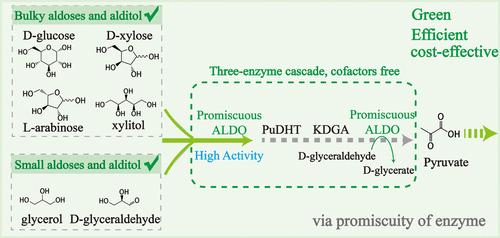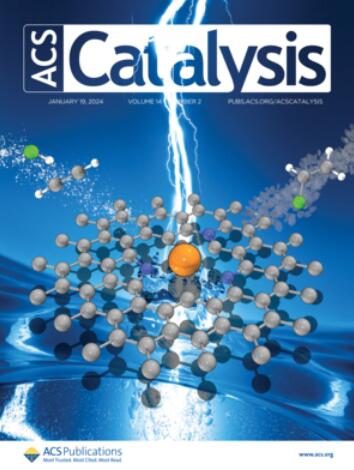ScALDO的底物混杂性工程实现了多功能最小化酶级联,以有效利用各种糖
IF 11.3
1区 化学
Q1 CHEMISTRY, PHYSICAL
引用次数: 0
摘要
随着化石燃料的枯竭,研究人员开始关注利用废弃的生物质资源及其单体糖来生产化学品。在本研究中,我们通过底物混杂工程重塑了来自链霉菌(Streptomyces colicolor, ScALDO)的糖醇氧化酶活性位点,并鉴定出一个对C3到C6醛糖和糖醇具有高混杂性的突变体ScALDO/Q288G。活性位点袋体积分析、空间位阻分析、分子动力学模拟和动力学参数研究表明,ScALDO/Q288G通过扩大的活性位点袋实现环d-葡萄糖的氧化,降低了底物的空间位阻,促进了氢化物的转移。为了进一步阐明ScALDO/Q288G氧化环醛糖的催化机制,我们提出了一种可能的机制,即初始氢化物转移,随后自发水化和开环。进一步的组合突变产生了最佳变体ScALDO/Q288G/E53D/V256E/E348P (M4),显示出d-木糖活性增加68.8倍以上,d-核糖活性增加268倍,同时也显示出显著的d-葡萄糖氧化活性。M4还对较小的底物(如d-甘油醛)保持显著的活性,并表现出优异的热稳定性(Tm = 68.7°C)。使用M4,我们建立了最小化糖酵解级联(MGC)。MGC高效利用d-葡萄糖、d-木糖、l-阿拉伯糖、d-半乳糖和木糖醇等多种底物生产丙酮酸,24 h内5 mM d-葡萄糖转化为9.08 mM丙酮酸,产率达90.8%。综上所述,我们创造了M4,它对C3到C6醛糖和糖醇具有高度的催化乱交性,从而可以建立一个利用各种糖的MGC。除了在MGC中的应用之外,M4还具有用于所有涉及醛糖和各种大小的糖醇的级联的潜力,以减少所需酶的数量。本文章由计算机程序翻译,如有差异,请以英文原文为准。

Substrate Promiscuity Engineering of ScALDO Enables a Versatile Minimized Enzyme Cascade for Efficient Utilization of Various Sugars
The depletion of fossil fuels has turned researchers’ attention toward utilizing waste biomass resources and their monomeric sugars to produce chemicals. In this study, we reshaped the active site pocket of alditol oxidase from Streptomyces coelicolor (ScALDO) through substrate promiscuity engineering, and a mutant ScALDO/Q288G was identified with high promiscuity toward C3 to C6 aldoses and alditols. Active site pocket volume analysis, spatial steric hindrance analysis, molecular dynamics simulations, and kinetic parameter studies revealed that ScALDO/Q288G achieves oxidation of cyclic d-glucose through an expanded active site pocket, reduces spatial hindrance for substrates, and facilitates hydride transfer. To further clarify the catalytic mechanism of ScALDO/Q288G in oxidizing cyclic aldoses, we proposed a possible mechanism that involves initial hydride transfer followed by spontaneous hydration and ring opening. Further combinatorial mutations produced an optimal variant, ScALDO/Q288G/E53D/V256E/E348P (M4), showing over a 68.8-fold increase in activity for D-xylose and 268-fold for D-ribose, while also demonstrating significant d-glucose oxidation activity. M4 also maintains significant activity toward smaller substrates, such as d-glyceraldehyde, and exhibits superior thermal stability (Tm = 68.7 °C). Using M4, we established a minimized glycolytic cascade (MGC). MGC efficiently utilizes diverse substrates, including d-glucose, D-xylose, l-arabinose, D-galactose, and xylitol, to produce pyruvate, with a conversion of 5 mM d-glucose to 9.08 mM pyruvate within 24 h, achieving a yield of 90.8%. In conclusion, we created M4, which exhibits high catalytic promiscuity toward C3 to C6 aldoses and alditols, thus enabling the establishment of an MGC for the utilization of various sugars. Beyond its application in MGC, M4 holds the potential to be used in all cascades involving aldoses and alditols of various sizes to reduce the number of enzymes required.
求助全文
通过发布文献求助,成功后即可免费获取论文全文。
去求助
来源期刊

ACS Catalysis
CHEMISTRY, PHYSICAL-
CiteScore
20.80
自引率
6.20%
发文量
1253
审稿时长
1.5 months
期刊介绍:
ACS Catalysis is an esteemed journal that publishes original research in the fields of heterogeneous catalysis, molecular catalysis, and biocatalysis. It offers broad coverage across diverse areas such as life sciences, organometallics and synthesis, photochemistry and electrochemistry, drug discovery and synthesis, materials science, environmental protection, polymer discovery and synthesis, and energy and fuels.
The scope of the journal is to showcase innovative work in various aspects of catalysis. This includes new reactions and novel synthetic approaches utilizing known catalysts, the discovery or modification of new catalysts, elucidation of catalytic mechanisms through cutting-edge investigations, practical enhancements of existing processes, as well as conceptual advances in the field. Contributions to ACS Catalysis can encompass both experimental and theoretical research focused on catalytic molecules, macromolecules, and materials that exhibit catalytic turnover.
 求助内容:
求助内容: 应助结果提醒方式:
应助结果提醒方式:


